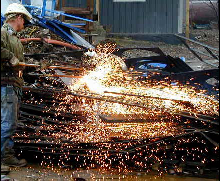Preventing Lead Exposure during Metal Recycling
- Preventing Lead Exposure During Metal Recycling (PDF, 81KB, 1pg.)
The New York State Department of Health, Bureau of Occupational Health and Injury Prevention and the Institute of Scrap Recycling Industries, Inc., completed a Metal Recycling Industry Project (MRIP) in June 2006. During this project, information was collected on metal recycling operations and processes from 101 metal recyclers throughout New York State. This project included measuring workers lead exposures during routine tasks, such as sorting, shearing, and torch cutting a variety of materials. Findings from this project include:

- Significant lead exposure occurred when torch cutting not only painted metals, but also unpainted metals and new steel;
- Lead contamination was found in bathrooms, in lunchrooms, and on workers' hands prior to eating;
- Metal recycling companies did not recognize potential sources of lead exposure (such as new steel) and underestimated the degree of exposure; and
- Metal recycling companies that we visited made substantial improvements to their lead protection programs after receiving information and technical guidance.
Recommendations
- Institute a blood-lead monitoring program for all employees potentially exposed to lead;
- Implement engineering controls, such as replacing torch cutting with shearing, to reduce workers' lead exposures;
- Implement employee lead training programs;
- Conduct personal air monitoring to assess airborne lead exposures;
- Provide respiratory protection to all workers who perform torch cutting, radiator disassembly or other tasks associated with high airborne lead exposures;
- Require employees to clean the interior and exterior surfaces of their respirators daily;
- Provide hygiene facilities, such as a clean lunch room, a locker room with separate "clean" and "dirty" lockers, and a shower facility;
- Prohibit eating, drinking, and smoking in any area where lead contamination may occur; and
- Perform routine housekeeping to reduce surface lead dust accumulation throughout the facility.
If you would like more information about these recommendations, contact the Bureau of Occupational Health and Injury Prevention at 518-402-7900 or 1-800-807-2130.